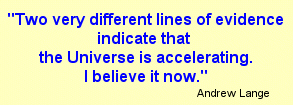Andrew Lange, scientist on the BOOMERANG project
"Two-thirds of the Universe seems to be of an unknown form of dark energy" - an interview with Andrew Lange, of the BOOMERANG project
02-May-2001
The Universe started as a very hot, small and opaque place: because of the high temperatures light interacted closely with matter - as if they were both 'stuck' together - and could not travel freely. But with time the Universe expanded and cooled, and about 300 000 years after the Big Bang its temperature was low enough for light and matter to separate. That primeval light can still be detected today. It is called the Cosmic Microwave Background radiation (CMB) and it holds a wealth of information about the early Universe. In 2007 ESA's Planck satellite will analyse the CMB with the highest accuracy ever achieved, but in the meantime several instruments worldwide are already working to acquire as much data as possible. Recent results from an international balloon experiment called BOOMERANG (Balloon Observations Of Millimetric Extragalactic Radiation ANd Geomagnetics) were released in April 2001. Andrew Lange, of the California Institute of Technology (Pasadena, United States), leads the American team.
In this interview, conducted in January 2001 during a Planck workshop at ESTEC, the European Space Agency's centre in Noordwijk (the Netherlands), Lange explains some of the results from BOOMERANG and considers what the Planck mission will contribute to our understanding of the CMB.
Andrew Lange, leader of the American team in the BOOMERANG project | |
|
|
Q: In 1992, NASA's COBE satellite confirmed that the CMB still bears the 'imprints' left by matter in the early Universe, when light and matter were coupled together. To be precise, these imprints were left by the 'seeds' of the large structures we see in today's Universe, such as the large galaxy clusters, and they appear as very slight changes in the CMB's temperature. BOOMERANG is a 'second generation' instrument compared to COBE, and ESA's Planck represents the 'third generation' of instruments to study the CMB. What are the main differences between them?
A: BOOMERANG was the first experiment to resolve the structures in the CMB, allowing us to 'see' structures that predate even the first star or galaxy in the Universe. In comparison with the image that Planck will some day produce, however, the BOOMERANG map is of a much lower quality, and it covers only about 3% of the sky. The Planck map will have greater angular resolution, will measure many more frequencies, and will cover the entire sky. So we will learn dramatically more from Planck.
Q: Can you expand on that?
A: People describe the model of the Universe with twelve parameters or so [such as the rate of expansion of the Universe or the nature and density of the so-called dark matter, among others]. When the quality of the measurement improves you will be able to measure more and more of those parameters. The easiest to measure is the geometry of the Universe, this is the one measured by BOOMERANG. Planck will be able to measure ten or more parameters, each with more accuracy than that achieved by BOOMERANG. Planck will be revolutionary.
| |
. | |
|
|
Q: To analyse the information hidden in the CMB Planck will measure the temperature of the whole sky, looking for tiny variations - some only a few millionths of a degree Celsius (0.0000001oC) - in the temperature of the CMB. But how can you be sure of your measurements if there are many other sources close by which will be also detected by the instruments?
A: It has to be understood that these measurements are very different from most astronomical observations. They are more like a high-energy physics experiment than an astrophysical observation. And they are very difficult. Generations of sub-orbital experiments like BOOMERANG have taught us how to separate the CMB signal from the many other sources that can contaminate the measurement. Using this experience, both the theoreticians and the experimentalists are trying to anticipate as much as they can all the sources of contamination that will affect Planck, and to find ways to either prevent them from occurring (that's the goal of the experimentalists) or to identify them in the data. But it will certainly be a very difficult mission. Even if the instrument works perfectly, I estimate that for the basic results it will require hundreds of man-years of analysis effort to fully extract all of the information from the data.
Q: There are about 300 physicists worldwide involved in Planck. Is this normal for a cosmology experiment, or is this a new way of doing research in this field?
A: The size of the team is normal for a high-energy physics experiment. But we are astronomers and we have no experience in working in such a big group, so one of the things we have to do is to learn the sociology...
Q: BOOMERANG found strong evidence in favour of a 'flat' Universe, that is, a Universe in which the density of matter is exactly the so-called 'critical density' This in turn favours the 'inflation' models, which imply that during the first moments after the Big Bang the Universe went through a phase of amazingly quick expansion. How are these concepts related?
A: There are a dozen parameters to describe the Universe and inflation makes very specific predictions about a few of them. The geometry of the Universe is one of these parameters, and it is related to the density of the Universe. Only five years ago we were arguing whether the density of the Universe is 0.3 or 1. For a flat Universe you need a density of 1 [a density smaller than 1 would result in an 'open universe' that expands forever, whereas a density larger than 1 leads to a re-collapse of the Universe in the future, in a sort of 'big crunch'. In a flat Universe the density of the Universe is just right to stop the expansion but also to avoid a re-collapse]. Now Boomerang tells us that the density is in fact very close to 1. And if the geometry is confirmed to be flat, that will be strong support in favour of inflation. The enormous expansion at the very beginning would have stretched the geometry of space until it was perfectly flat. Planck will be able to tell us the density - and thus the geometry - of the Universe to within 1%, and that will be very interesting.
| |
. | |
|
|
Q: The fact that the Universe is flat, is that enough to confirm inflation?
A: Inflation makes predictions also about how the anisotropies, the slight differences in temperature that we measure, are distributed on the sky. So we can go and measure the numbers that go with those predictions. But then we will measure other parameters that are not directly related to inflation, like the density of non-ordinary matter (matter that we know is there though we don't know what it is), or the density of this dark energy. [Independent measurements seem to confirm the fact that the Universe is accelerating, possibly due to the action of a 'dark energy' which has yet to be measured and which some call 'quintessence'].
Q: Other experts are sceptical about the quintessence or dark energy [see the interview with Joseph Silk].
A: There are two different lines of evidence now, and I think that the evidence is very firm. The supernova results give evidence that the expansion of the Universe is increasing as a function of time. But independent of that, the BOOMERANG results together with the distribution of matter today, also lead us to conclude that about two thirds of the energy of the Universe must be in this unknown dark form. And in fact if you look at the value measured by the supernova results and those measured by BOOMERANG, together with the large scale structure observations, they agree very well. So there are two very different lines of evidence indicating that the Universe is accelerating. I believe it now.
Q: What would the dark energy be made of?
A: Nobody has any idea, which is why it is so interesting. And this is also another reason to compare this with a physics experiment, because this is not the conventional topic studied by astronomers.
Q: This year NASA will launch the Microwave Anisotropy Probe (MAP), another mission to study the CMB. Will it leave room for Planck?
A: MAP is an intermediate step between Boomerang and Planck. It will achieve all-sky coverage, but will not have the sensitivity, nor the angular resolution, nor the frequency coverage of Planck.
Q: Which questions will Planck leave unanswered?
A: Many, of course. In terms of the CMB itself, we will still want to know more about the polarisation. Gravity waves from the beginning of the Universe can polarise the CMB and leave a very specific signature in it. It is very difficult to detect, but if we can detect it we will actually be looking back all the way to a tiny fraction of a second after the Big Bang. We think now that the Universe went through a period of inflation, and the signature we can look for is that during inflation there was a huge expansion of matter, and a lot of gravity waves were produced, and those have been transmitted to us. The only way we can see them today is by looking at the effect they have on the CMB. I don't know if I'll be alive when that happens, but we are already working on technologies for a mission beyond Planck. We began to work on the technologies for Planck eleven years ago... so now it is the right time to work on future missions. What will we discover with them? We don't know. The great thing here is that you can not predict what's going to come next. Five years ago no-one took the idea of the dark energy seriously...
 Background on BOOMERANG
Background on BOOMERANG
BOOMERANG (Balloon Observations Of Millimetric Extragalactic Radiation ANd Geomagnetics), obtained its images using an extremely sensitive telescope suspended from a balloon that circumnavigated the Antarctic in late 1998. The balloon, with a volume of 800 000 cubic meters, carried the two-tonne telescope at an altitude of almost 37 km for ten and a half days. First results were published in the April 27, 2000 issue of Nature. More recent analysis of the BOOMERANG data has provided the most precise measurements to date of several of the key characteristics which cosmologists use to describe the Universe.
The 36 team members of the BOOMERANG project are from 16 universities and organisations in Canada, Italy, the United Kingdom and the United States. Primary support for the BOOMERANG project comes from the National Science Foundation (NSF) and NASA in the United States; the Italian Space Agency, Italian Antarctic Research Programme and the University of Rome 'La Sapienza' in Italy; and the Particle Physics and Astronomy Research Council in the United Kingdom.
More information on BOOMERANG can be found at http://oberon.roma1.infn.it/boomerang/ or at http://www.physics.ucsb.edu/~boomerang/
 About Planck
About Planck
The Planck satellite, one of ESA's main missions for this decade, has been designed to help answer key questions for humankind: how the Universe came to be and how it will evolve. To fulfil its mission Planck will examine with unprecedented sensitivity and angular resolution, the small anisotropies of the first light that filled the Universe after the Big Bang, the so-called Cosmic Microwave Background radiation. It will carry two arrays of highly sensitive detectors that are now being built by more than 40 institutes, most of them European and some from the United States. Planck will be launched in 2007 together with ESA's far-infrared space telescope, Herschel. They will separate shortly after launch and will be operated independently from different orbits around the second Lagrangian Point located about 1.5 million kilometres away from Earth.
 Contact Person
Contact Person
Jan Tauber, Planck project scientist
Tel: +31 71 565 5342
E-mail: Jan.Tauber esa.int
esa.int



